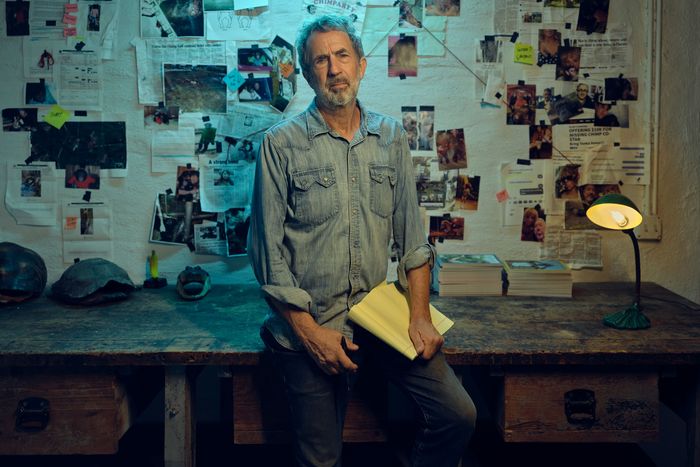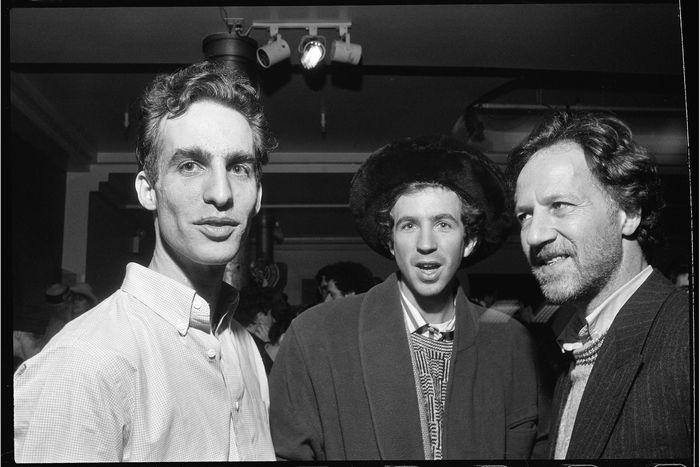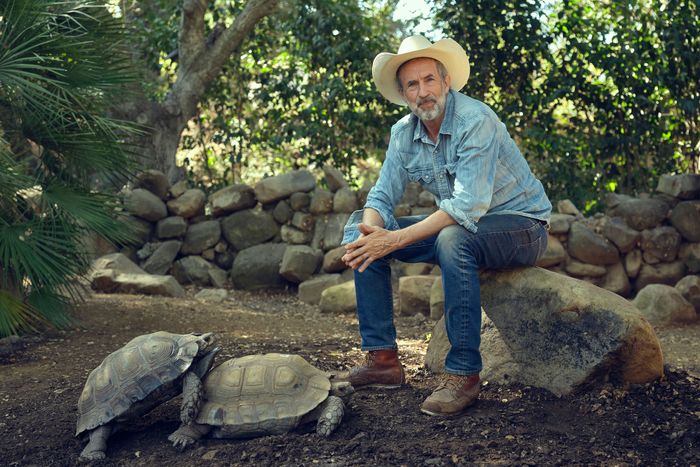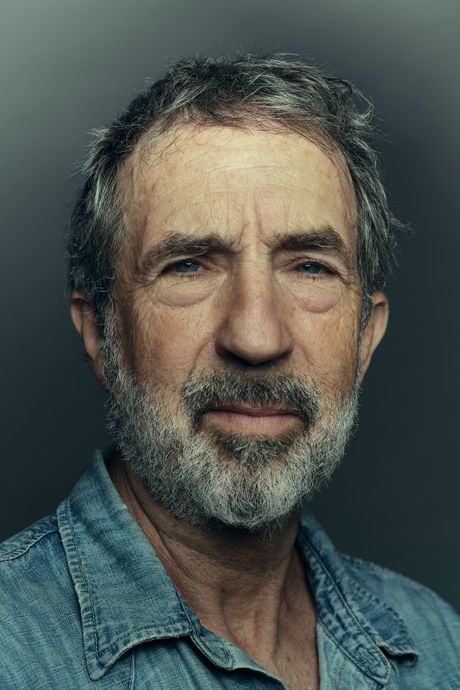Bussiness
Eric Goode’s Monkey Business
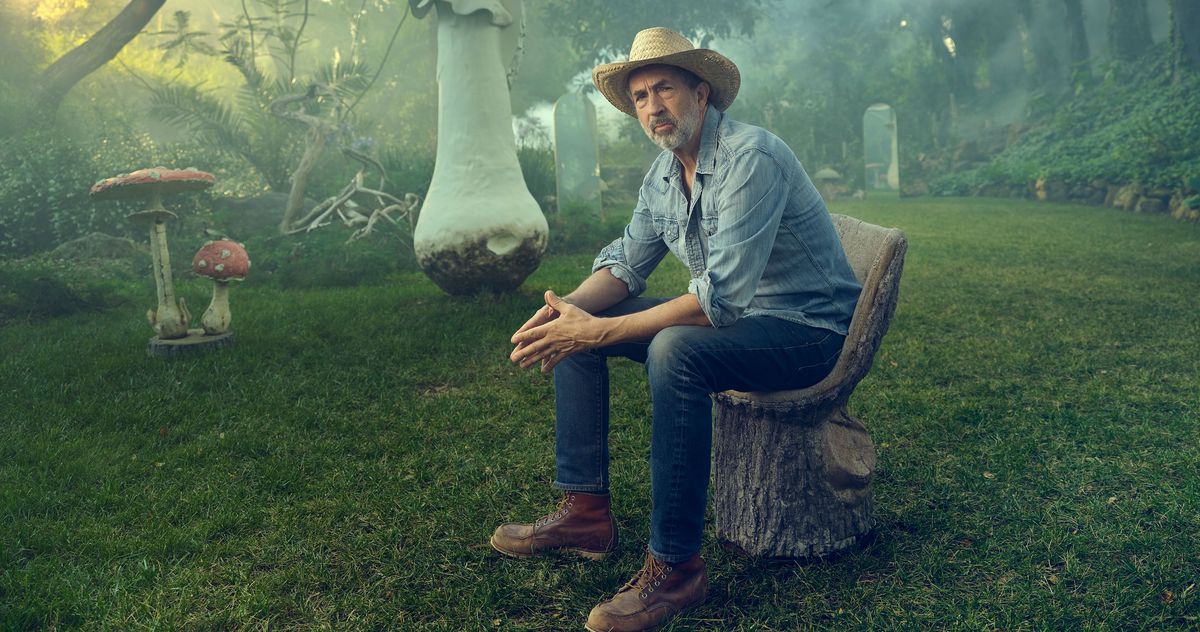
Warning: The following story contains mild spoilers for unaired episodes of HBO’s Chimp Crazy. If you would prefer to experience the September 8 finale with wide-eyed, capuchin-like naïveté, read this later.
Let’s see if we can get them to mate.”
Eric Goode, the conservationist and creator of the 2020 Netflix docuseries Tiger King, is determined to give me a show. It’s a sunny June day at the Turtle Conservancy in Ojai, California, a breeding facility for endangered turtles and tortoises that he operates near his home. We’re standing over a pen of plowshare tortoises, which are among the rarest animals on earth, and Goode tells an employee to place a male near one of the females. “He’ll circle her repeatedly and then he’ll use that gular scute” — a bony plate — “under his chin to flip her over,” says Goode. “It’s a very violent mating ritual.”
We wait a few minutes, but alas, there’s no circling, no flipping, and no mating. The male plowshare is either insufficiently horny or just slow to get down to business, so he’s returned to his own enclosure. “We’ll go look at something else,” Goode says, and he walks me through a greenhouse where the facility’s associate director, a Frenchman named Simon Rouot, holds up a Burmese star tortoise.
When we get back outside, there’s a surprise waiting. In a nearby paddock, a large tortoise has mounted one of its neighbors and is thrusting with gusto. “Those are radiated tortoises from Madagascar,” Goode says over the sound of their clanking shells. “They have a strong appetite for sex.”
“And they’re both males,” says Rouot.
“Well,” says Goode, “that’s what happens when you deprive them of females.”
I mention the scene above not just for titillation but also because it happens to contain the three basic ingredients of Goode’s documentaries: exotic animals, eccentric humans, and a left-field twist that greatly improves on whatever best-laid plans Goode came in with.
Tiger King, which he produced and co-directed with Rebecca Chaiklin, began as a Best in Show–style comedy about tiger owners who were as uncommon as their cats. Then it became something completely different when Oklahoma zookeeper Joe Exotic, whom Goode had been filming for five years, solicited an undercover FBI agent to murder his nemesis, Carole Baskin, who, the show alleges but never proves, may have killed her former husband and fed his body to tigers.
Goode’s latest project also wound up miles from where it started. Chimp Crazy, now airing on HBO, is about the strange phenomenon of monkey moms — human women who adopt chimpanzees and raise them like children, an arrangement that tends to end badly. As they reach maturity, chimps can become aggressive, especially when confined to small spaces (such as a house) and denied contact with other primates. Chimp Crazy investigates a number of chimp-related tragedies, including the infamous case of Travis, the chimp who, in 2009, ripped a Connecticut woman’s face off. But its main real-time story line follows Tonia Haddix, an exotic-animal broker from Missouri. When PETA wins a court order to confiscate her chimp Tonka, Haddix goes to extremes to keep him, triggering a chain of events that pushes Goode and his crew to make an emergency intervention.
It’s possible that you’ve never heard of Goode, even if you’re among the tens of millions of people who streamed Tiger King. He’s a minimal presence in his work, infrequently appearing on-camera or in voice-over. He was, in another life, a hospitality mogul behind a host of storied New York nightclubs and hotels, and nobody could have expected him to be any good at filmmaking. But now that he’s made one of the most entertaining and unpredictable animal documentaries ever, and followed it with another that might be even more shocking, he seems destined to be a name brand.
So what does it take to become the most exciting documentarian of the moment, someone whose work is commercial but also charged with the avant-gonzo ethos of cinematic trash collectors like John Waters and Harmony Korine? It turns out you need money, vision, a disdain for the corporate streaming-TV content mill, and a willingness to break a few journalistic rules.
Also, you need luck. Lightning doesn’t usually strike twice, and it’s even less likely that the same doc-maker would be there, ready with a camera, both times. How does Goode manage to be in exactly the right place? “When people saw Tiger King, they said, ‘Oh, this is reality TV,’ because it seemed too crazy to be a straight documentary,” he says. “If I were a critic, I’d ask, ‘How is it possible that this guy starts filming with Joe Exotic and then Joe tries to kill Carole and then, a few years later, the same guy does another documentary and the woman he’s filming winds up kidnapping a chimp? They must have made her do it or made this story up.’ But there’s nothing in Tiger King or Chimp Crazy that’s not documentary. I could understand people being skeptical, though, because what are the odds?”
Goode at home. His filmmaking process involves time, money, and extensive research into his subjects.
Photo: Justin Bettman
Goode’s home in Ojai, at the base of the Topatopa Mountains, about 90 minutes northwest of L.A., is hidden behind trees and easy to miss from the main road. This is presumably by design. Many of the reptiles on the premises belong to species that are extinct in the wild, which makes them valuable on the black market. On the morning of my first visit, he calls to give me directions and the code for the gate.
When I arrive, Goode is on the phone with his executive producer and right hand, Jeremy McBride, who’s working on the final color corrections for Chimp Crazy this week. The doc’s title has only just been finalized, and Goode has mixed feelings about it. “HBO liked Chimp Crazy, but it wasn’t my favorite,” he says. “The name I liked most was Humanzee. That’s how Tonia would sometimes refer to Tonka, because he was a chimp caught in the human world, and that’s what the whole story is about. But HBO was worried people wouldn’t know how to pronounce it. And for a moment I wanted to call it Apeshit, but they didn’t like that either.”
Goode, who’s wearing jeans, a blue T-shirt, and a face full of gray stubble, is moving slowly, still recovering from a left-hip replacement three weeks ago. (“I used to play a lot of street basketball,” he says.) He insists on giving a tour anyway. We climb into a Kawasaki utility vehicle, and he drives us around the property, which has been his primary residence since 2019. There’s the main house, guest bungalows, a tennis court, Japanese gardens, rock bridges, pools, and a giant mushroom sculpture by the German artist Carsten Höller. Goode first bought a vacation home here in 1989, and he’s been adding adjacent lots as they’ve become available. His compound now spans 100 acres.
In his Area heyday, Goode mixed entertainment with the avant-garde. Here, he’s seen with artist John Lurie (left) and Werner Herzog (right).
Photo: Wolfgang Wesener
Most documentarians, needless to say, do not have their own Xanadus. But Goode, 66, came to filmmaking late, after being fortunate in other careers. In the ’80s, he created a series of nightclubs in New York, most notably Area, which was legendary for redesigning itself every six weeks to fit a different theme. For “Suburbia,” Goode and his partners attached the façade of a ranch house to the club’s Tribeca entrance, and for “Science Fiction,” they built dioramas of extraterrestrial landscapes and hung a rocket ship above the dance floor. His friends Andy Warhol, Keith Haring, David Hockney, and Jean-Michel Basquiat were known to pitch in on the decorations. Then, in the ’90s and aughts, Goode opened swanky restaurants across lower Manhattan — Time Café, BBar, the Park, the Waverly Inn — and boutique hotels, including the Maritime, the Bowery, the Jane, and the Ludlow. His establishments defined the downtown culture of those decades, and a couple are infested with celebrities and TikTokers to this day.
Goode was a multi-hyphenate creative director before everybody in New York claimed to be one. He practiced an elevated, auteurist form of hospitality, imposing his aesthetic vision on his establishments down to the last ambient details. It made him wealthy and a little famous. He dated supermodels (Naomi Campbell, Rachel Williams), actresses (Julianne Nicholson), and practically everyone else. “When I was young, I had delusions of grandeur and thought I was a rock star,” he says.
In person, Goode is friendly but reserved. He listens as much as he talks — his resting facial expression is one of compassionate curiosity — which might explain how he gets so many of his documentary subjects to hang themselves. Friends describe him as shy, but then again, everybody I run into claims to be his friend, so he can’t possibly be that shy. In the two days I’m with him, he makes and receives phone calls constantly, usually on speaker, with everyone from the artist Tom Sachs to the primatologist Russell Mittermeier. “It’s a light shyness,” says the stylist Elizabeth Saltzman, whom Goode dated in the mid-1980s. (Now single and never married, he’s on remarkably good terms with many of his ex-girlfriends.) “He’s not scary or unapproachable. You can see it in his body language. He’s the ‘Oh, golly, me?’ guy.”
In other words, Goode would hate to be thought of as a shark, even if he sometimes looks like one. In 2019, just months before COVID, he made a deal with developers to knock down BBar and replace it with a 22-story office building. The 99-year ground lease pays him $125,000 a month to begin. The building, 360 Bowery, was recently finished. “I gentrified the poor neighborhood,” he says.
Now he’s making films. Sometimes, the result is the most preposterously successful documentary in the world, and other times it’s a personal project that few will ever see. He shows me footage from three upcoming docs that are still in progress, one of which has already been sold to HBO, plus a completed one, Wildflower, about his parents and childhood in Sonoma, California. “I made that for my mom” — the environmentalist Marilyn Goode, who died in 2022 at 92 — “to make her feel valued as she aged, but I don’t know if it’ll end up anywhere,” he says.
At his Turtle Conservancy in Ojai, California.
Photo: Justin Bettman
Goode’s greatest preoccupation, the one that all the others seem to revolve around, is reptiles. His obsession began at age 6 with a pet tortoise and spiraled from there. “I always had two separate lives. I could talk to people about contemporary art and business and fashion and all the things you talk about in New York,” he says. “But I could also talk to people about animals. Whenever I took a vacation, I would go some place where there were reptiles.” Saltzman confirms as much: “He brought me to Negril, and I only found out later that it was because he wanted to look for Jamaican iguanas. He fully expected to find one, even though they had been extinct since the 1940s. They were rediscovered later, in 1990, though, so he wasn’t totally wrong.”
In 2005, Goode established the Turtle Conservancy to house 250 rare tortoises that were displaced when the Bronx Zoo closed one of its research stations. Its population has grown by several hundred animals since. “I’m sure you’re wondering what makes me different from Joe Exotic. He had tigers; I have tortoises,” says Goode. For starters, he explains, unlike the exploitative roadside zoos featured in Tiger King, the conservancy is not open to public gawkers. Many of its inhabitants have been confiscated from illegal traffickers, and Goode’s aim is to reintroduce as many as possible back into the wild. The conservancy has purchased about 100,000 acres of protected habitat around the world. He hopes the proceeds from the BBar land deal will keep his conservationist initiatives going after he dies.
Still, anybody who thinks this much about turtles must be at least a little touched. “It takes one to know one, and I do share some pathology with the crazier people in this world,” Goode says. “I can understand the feeling of wanting the animal that you can’t get.” Most of the Turtle Conservancy’s plowshare tortoises came from confiscations in China and Taiwan, but Goode tried without success to get some from Madagascar, too: “I gave the minister of the environment at that time a blank check that he could fill in, and he just wouldn’t do it. He could’ve written a million dollars in there if he wanted to.”
Goode’s reptile interests were his doorway into documentaries. He made nature shorts — The Argentine Tortoise, In Search of the Okinawa Leaf Turtle — and PSAs for the Turtle Conservancy to raise awareness of animal trafficking. Then he realized that some of those traffickers made pretty interesting subjects. Goode had once thought of his nightclubs, which attracted weirdos and squares alike, as venues for sneaking outsider culture into polite society. It occurred to him that docs might let him do something similar. “I’ve always been interested in the eccentric and looking under the rocks in places that don’t seem overtly interesting, beyond New York and L.A. That’s where you discover the Tonia Haddixes of the world,” he says. “Joe Exotic and chimpanzees could very well have been themes at Area.”
Goode’s technical filmmaking experience was limited. As a kid in Sonoma, he shot Super 8 movies with his brother. When he got to New York, he worked odd jobs for movies such as Saturday Night Fever, but he was frustrated by the gigs. “I didn’t learn anything about making films other than I didn’t like it because I just sat around all the time,” he says. Later, he co-directed music videos for Nine Inch Nails and Robbie Robertson. There was little to suggest he was ready to jump into features, but that was no great hurdle, he says: “I didn’t go to film school, but I never went to hospitality school either. Whenever I do anything, I just assemble a group of like-minded people and we figure it out.”
To this end, it should be noted, Goode is an excellent talent scout, able to spot potential that may not be obvious from a candidate’s CV. Many of the people who work on his docs are also multitaskers from nontraditional backgrounds. McBride, whose previous job was in private equity, handles a range of Goode’s businesses, managing his real-estate interests and now his production shingle, Goode Films. James Liu, a producer on Tiger King and Chimp Crazy, was first a veterinarian at the conservancy.
Goode and his team found that his ability to talk shop with animal nuts opened doors that had been closed to other doc crews. “With documentaries, the most important thing is knowing how to navigate worlds that are not so easy to get into,” he says. “The people who keep exotic animals are super-guarded and afraid of three things: Feds; people who will steal their animals, because they’re worth a lot; and the media, because journalists will write bad things about them. But I know enough about animals to connect with them.” “Eric is an insider, an intense and obsessive herpetologist,” says director Josh Safdie, whom Goode once hired, along with his brother, Benny, to make PSAs for the Turtle Conservancy back when they were just unknown jobbers. “No one else could have gotten into that world. They recognized Eric as one of their own.”
Goode has two additional advantages over most documentarians: time and money.
As streaming services invested heavily in documentaries this past decade, documentaries themselves changed. New players entered the market to take advantage of the surging demand, and the competition forced them to prioritize speed and volume over quality. Now, many so-called docs are made fast and on the cheap, often just slapping together stock footage, a few establishing shots, and talking-head interviews that retell a story that’s already taken place. There are fewer of the ambitious yearslong stakeouts that produced genre-defining classics such as Hoop Dreams, American Movie, and Paris Is Burning. There are more self-lionizing celebrity memoirs (Beckham, Taylor Swift’s Miss Americana), nostalgic retrospectives (The Greatest Night in Pop, Brats), true-crime rehashes (Murdaugh Murders: A Southern Scandal, Conversations With a Killer: The Jeffrey Dahmer Tapes), and recaps of Fyre Festival (Fyre, Fyre Fraud). “They’re almost all scripted, in a sense, because before they start the doc, they know where they’re going,” Goode says.
In 2017, CNN hired Goode to create and host a pilot for a show about animals. Because he’d never made a TV series before, the network had him work with Left/Right, the production company behind Showtime’s The Circus. “Everything Left/Right did was just insane and unhelpful,” he says. “They told us, ‘You get five days of shooting for a 50-minute program.’ And I was like, ‘How can that possibly work?’” Goode says Left/Right asked for a segment about an animal attack and suggested that he interview a child who had been bitten by a pet iguana. “We ended up disregarding their input and found a guy that had lost his leg to a tiger,” he says. The pilot was not picked up. “The part that made it really difficult was CNN owned everything we shot and we couldn’t use it again. Luckily, I knew in the back of my mind that I didn’t want to give them Joe Exotic.” (Left/Right did not respond to requests for comment.)
Now, Goode’s approach is more traditional and, crucially, self-funded. He shoots for years, identifying the subjects he’s most interested in and then waiting as long as it takes for a plot to develop. He’ll also change plans if something better comes along. Around 2014, he’d been making a documentary about reptile trafficking when he met a Florida man transporting a snow leopard in the back seat of a hot van. After the encounter, he switched focus to big-cat owners and, six years later, delivered Tiger King unto the world.
“We cast a wide net and then home in on the characters that rise to the top,” says Goode. For the past decade, he’s been investigating other animal subcultures, interviewing such personalities as Ojai taxidermist Chuck Testa, Miami deep-sea fisher Mark “the Shark” Quartiano, South African rhino breeder John Hume, and former Hollywood madam Heidi Fleiss, who now runs a parrot sanctuary in Nevada. Maybe these interviews will amount to something, but more likely they won’t. “What I can’t stress enough is the amount of footage that falls on the cutting-room floor,” says Goode. “This is not a get-rich-quick scheme and not a recipe to follow if you’re trying to run a successful production company.”
Of course, now Goode’s own production company is extremely successful. “I realized at a certain point Tiger King was going to do well,” he says. “But not that well.” The series debuted in March 2020, when much of the world was mandatorily couchbound under COVIDprotocols. According to Netflix, 64 million households watched at least some portion of Tiger King during its first month, a ridiculous-sounding statistic that nonetheless rings true given the explosion of memes, parodies, and Halloween costumes the show inspired. On his way back from a shoot for season two, Goode was pulled over in Texas for speeding. The cop processed his information and then asked, “Did Carole do it?”
Tiger King was life-changing for its subjects, too. At first, most were happy with the attention and found ways to monetize it. Eventually, the opportunities waned and a bitterness set in among certain members of the cast. The series, they decided, had made them look like a bunch of animal-abusing polygamous yokels. “Let me show you something lovely,” says Goode. He hands me his iPhone, which is open to a long one-sided text conversation with James Garretson, the Florida Jet Ski entrepreneur who informed on Exotic to the FBI. Garretson has sent Goode the same image, hundreds of times, of a cartoon middle finger.
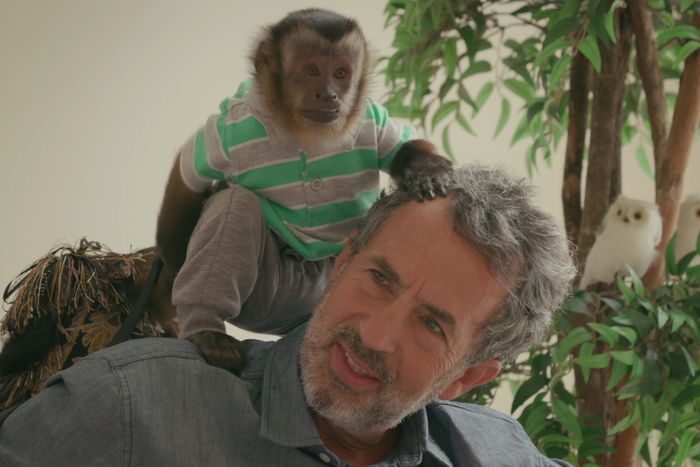
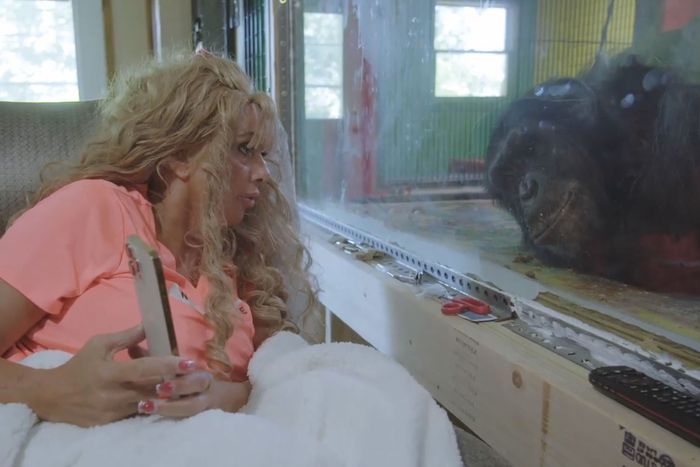
Goode monkeying around on the set of Chimp Crazy; Tonia Haddix with Tonka, who specialists say might have been experiencing depression in captivity. Photo: MAX.
Goode monkeying around on the set of Chimp Crazy; Tonia Haddix with Tonka, who specialists say might have been experiencing depression in captivity. P…
Goode monkeying around on the set of Chimp Crazy; Tonia Haddix with Tonka, who specialists say might have been experiencing depression in captivity. Photo: MAX.
All of this animus made shooting Chimp Crazy more complicated. The community of private exotic-animal owners is small and tight-knit, and after Tiger King, Goode’s name was mud. So he came up with a workaround: He lied. Be warned: What follows is an account full of spoilers for Chimp Crazy.
Goode had been filming monkey moms for years, even before Tiger King. He was fascinated by their psychology. “It’s a lot about the selfish need for attention they get from having a chimpanzee,” says Goode. “You can walk down the street with a human baby in a stroller and not get the attention you would with a chimp. But it also serves a maternal need.” Travis’s owner, Sandy Herold, bought her chimp after the death of her human daughter.
Chimp Crazy began in earnest in 2021 with a visit to Pam Rosaire, an animal trainer from Sarasota, Florida. Rosaire and her sister, Kay, run a zoo called Big Cat Habitat, which has been cited by PETA for animal cruelty. (“And by the way,” says Goode, “the Rosaires only named it that to annoy Carole Baskin, whose facility is called Big Cat Rescue and is less than two hours away. That’s how incestuous all of this is.”) In negotiating access to Rosaire, Goode’s producers withheld the important detail that they were working for the man behind Tiger King. “We shot with Pam during the middle of COVID,” he says. “I was worried they would recognize me, but I had my mask and hat on and I didn’t say who I was. I just made myself look like I was part of the crew.” The shoot went so well — Rosaire tells Goode’s cameras that she once breastfed one of her chimps — that he decided to focus on monkey moms above all the other animal subcultures he’d been following.
Goode’s next target was Connie Casey, a breeder based in Festus, Missouri, whose facility, the Missouri Primate Foundation, was once the top supplier of all privately owned chimpanzees in the U.S. Her animals had a record of violence. She sold Travis to Herold in 1995, and another of her chimps, Bo, bit off her then-husband’s nose. Casey had been battling a lawsuit from PETA, which said her apes were living in inhumane conditions in small cages filled with their own waste. In 2018, she had attempted to moot the case by transferring their legal ownership to a woman named Tonia Haddix; PETA argued that the move made no difference and simply added Haddix to the suit.
Haddix is a 55-year-old blonde-wigged animal trafficker with no formal husbandry training who calls herself the “Dolly Parton of chimps.” She advertises her services on Facebook and claims to earn as much as $350,000 a year selling primates, marsupials, and God knows what else as pets. “Sourcing the monkeys is highly involved and illegal,” says Liu. “She sells to a lot of celebrities, who end up discarding their animals in a year or two once they realize how much work they are.”
Haddix had her own chimp, Tonka, whom, she announces many times in the doc, she loves more than her two human children. In the ’90s, Tonka had been an actor, starring in George of the Jungle and Buddy with Alan Cumming. By the time Haddix adopted him, around 2017, he’d long since retired from movies and outgrown domesticated life. “I met Tonka in 1996, when he was about five years old, and he was a little sweetheart,” says Cumming. “But a year later, on the press tour for Buddy, he and I were supposed to be reunited on a morning talk show, and the trainer canceled his appearance. He told me, ‘He’s six now, so he’s sexually aggressive. He would probably try to shag you on live television.’”
Goode assumed that Casey and Haddix were not likely to speak to him, so he resorted to another deceit: He would hire someone else to approach the pair and say that he was making the film. In Chimp Crazy, Goode calls this job a “proxy director,” but in function, it’s a bit like a spy.
Goode knew just who to call. Dwayne Cunningham, an affable former Ringling Bros. circus clown, had worked with the Rosaires at the Big Cat Habitat and served prison time for reptile smuggling. He and Goode have different views on keeping exotic animals for pets — Cunningham is for it, even with chimpanzees, as long as the animals are treated humanely and kept with other primates. “I’d interviewed Dwayne for another project,” says Goode, “and he had the perfect credentials.” Sort of. “I had no filmmaking experience,” Cunningham says. “My father was a newspaper printer, and that’s as close to journalism as I had ever been before this.”
Casey ignored the production’s entreaties, but in the spring of 2021, Haddix met Cunningham and Liu for an introductory breakfast at a Holiday Inn Express. “She was living out of the hotel then,” says Liu, “and she had animals constantly coming and going out of her room. I saw spider monkeys, kangaroos, and all sorts of things in there.” Soon, they’d won Haddix’s trust. She agreed to participate and allowed cameras onto Casey’s property. Cunningham began interviewing her.
To Goode’s credit, he discloses and wrestles with most of these deceptions in the doc, and much of Chimp Crazy’s drama unfolds as the ruse escapes his control. “We used Dwayne to get to Tonia, but always with the intention that he would just start the conversation and then hand it off to me,” says Goode. “We just didn’t think he would hand it off the way he did.”
In June 2021, PETA won an order to have seven chimps living in Casey’s facility, including Tonka, removed by federal marshals and transferred to a Florida wildlife sanctuary. Haddix told reporters that her chimp would not make the trip — because he had died of heart failure the previous month and she’d cremated his body in her backyard fire pit. But nobody bought it. “We knew she was lying,” says McBride. “It was just hard to prove at the time.” In February 2022, PETA offered a $10,000 reward for information leading to Tonka’s return.
Tonka was, in fact, still alive. In January 2022, Haddix invited Cunningham and the doc crew to her home in the Ozarks to observe as she made a court appearance via Zoom. Under oath, she tearfully described the moment she found Tonka dead. And then she led Cunningham to her basement where the chimp had been living in a cramped enclosure. “We were like, ‘So where is Tonka?’” says McBride. “And she said, ‘Oh, he’s here. He’s right below where we’ve been sitting for the last five hours.’”
Haddix claimed Tonka was happy. In the doc we see him eat McDonald’s, drink soda, and play with a tablet computer. Goode consulted with experts, showing them footage of the chimp and asking them to analyze his body language. “When we saw Tonka in that cage, he was rocking back and forth,” says Goode. “That tic is what happens when chimps are held in captivity. It’s what they do when they’re bored out of their minds, and it was an indication to us that he shouldn’t be there.” Craig Stanford, a USC primatologist who worked with Jane Goodall, concurs: “We don’t see this in the wild, but in zoos, chimpanzees do all this neurotic stuff, including rocking. We might call it clinical depression.”
Around the same time, Goode noticed that his proxy director was acting strangely, too. Had Cunningham turned double agent? “He and Tonia became very, very close,” Goode says. “They were calling and texting off-screen. She was sharing things with him that she didn’t share with anyone else, and he would tell her things that he wouldn’t tell us. Dwayne and I had some confrontations, because his loyalty lied more with Tonia and he was effectively lying to us. I would bet that Dwayne knew Tonka was alive before we did.” (Cunningham denies this: “I found out after the Zoom call with the judge.”)
Eventually, Goode and his crew, and even Cunningham, decided to intercede on Tonka’s behalf. “There’s a conundrum that comes up over and over with people that are illegally keeping animals,” says Goode. “When you have a chimp, there are only a few options. You can try to launder it — give it to someone else who has chimps and hope that nobody knows it’s that chimp — or you can kill it.” They shared their findings with PETA, and in June 2022, Tonka was extracted from Haddix’s basement.
Somehow, though, Haddix did not seem to realize it was the documentary crew that had blown her cover, at least at first. On the weekend of Tonka’s removal, she invited Cunningham to her home. “I remember Jeremy saying, ‘Under no circumstances should Dwayne go into that house. There’s no way we can risk him walking into a trap,’” says Goode. “But Dwayne felt comfortable, so I said, ‘Let’s just trust his instincts.’” Cunningham strapped on a hidden camera and, in a scene out of Serpico, went to visit Haddix. “What’s crazy about that footage is that you know everyone else in the house knows Dwayne was the rat. Look at how her son looks at him,” says McBride. “But Tonia didn’t want to believe it.”
Days later, Haddix was contacted by a Rolling Stone reporter, who had gleaned from court filings that Cunningham was the snitch — and that he was working for Goode. Haddix told the magazine that she never would have cooperated with the documentary if she’d known Goode was behind it, and she vowed to block its release. “I’m gonna stop that production,” she said.
But Haddix kept talking, first to Cunningham and then, eventually, to Goode, who wound up interviewing her many times over a year and a half. “I actually became friends with Tonia,” says Goode. “But I don’t want to give myself too much credit. It turned out that she will talk to anybody about her case.”
Haddix characterizes her relationship with Goode differently. “We’re not friends, and he knows I don’t like him,” she tells me. She says she has largely made peace with what happened and takes some responsibility. (“Yes, I perjured myself to a federal judge, and it’s not something I’m very proud of.”) But on the day I spoke to her, Haddix said she had just seen an interview with Goode on the Today show and felt slighted. “I was only going to say that the documentary was okay and blah blah blah, but then he trashed me on TV.”
Haddix says that when she learned that Goode was behind the documentary, she consulted with lawyers about an injunction. “Nobody wanted to touch it, though, because of PETA. Plus Carole Baskin sued to get Tiger King 2 stopped, and her husband is an attorney, and they couldn’t get it done.” (The Baskins sued Netflix in 2021 seeking to block footage of them from appearing in Tiger King’s second season, because, they argued, they had only agreed to be in season one. The suit was later dropped.) Haddix says part of the reason she continued talking to the production was because she hoped it would allow her to see Tonka again, “but it never happened.”
Tonka is now living at the Save the Chimps sanctuary in Fort Pierce, Florida, a 150-acre facility where more than 200 rescued chimpanzees live and socialize across a dozen separate islands. Cumming went to visit shortly after Tonka’s arrival. “There’s something magical about the fact they’ve got their little islands and they’re in tribes together,” he says. “The chimps there are loved and looked after, but they’re also left alone to wander around free and be wild animals. Tonka looked like he was in such great shape, healthy, fit, and just happy.”
Goode says he’d wanted to end Chimp Crazy by reuniting Haddix and Tonka, but PETA and Save the Chimps wouldn’t allow it. “They see her as the devil,” he says. “I don’t think she’s ever seen a primate in the wild, and it would be so good for her. You would hope that she would start to understand why what she’s doing is so horrible. But it’s easy to vilify Tonia from afar. If you spend time with her, it’s hard not to like her, and it was hard for us to turn on her. I hope that she’ll see some benefit from this and that the end justified our means.”
Photo: Justin Bettman
Goode’s means have been vindicated before. Some of Tiger King’s critics worried that the series was too entertaining for its own good. Reviews called it exploitative and sensationalist. Animal-welfare groups complained that any conservationist message it might have had was lost among its narrative curveballs. Goode even said that he had wanted to take a more explicit stand against animal abuse but that Netflix and other collaborators had pushed the production in a “binge-worthy” direction. And yet, despite such concerns, Tiger King made the kind of direct-hit impact on its animating issue that most documentarians only dream of. In 2022, Congress passed the Big Cat Public Safety Act, which effectively outlawed unlicensed roadside zoos like Joe Exotic’s. The bill’s lead sponsor, Illinois representative Mike Quigley, said that Tiger King’s algorithm-breaking popularity was instrumental in bringing the bill to the Senate floor. “Tiger King got so much ridicule by people that felt we weren’t highlighting the cats enough,” says Goode. “But the net result was that it did a lot to make real change.”
Chimp Crazy’s moral should be easier to grasp. But just in case, the series ends with a title card: THERE IS STILL NO FEDERAL LEGISLATURE OUTLAWING THE PRIVATE OWNERSHIP OF CHIMPANZEES. “I’m not trying to be the animal police, and I’m not PETA. I think kids in America should be able to have a pet bearded dragon or a rosy boa,” says Goode. “But do I think people should keep a chimpanzee? No. They make terrible pets.”
“There’s this trend right now of very sincere nature films that pull on your heartstrings,” he says, citing the Oscar-winning 2020 doc My Octopus Teacher, in which a filmmaker befriends a cephalopod, and 2022’s Wildcat, about a British war veteran’s relationship with an ocelot. “Maybe it’s my jaded New York sensibility, but I’m less interested in that stuff. There are too many docs that only appeal to the converted, and you want to appeal to the non-converted. If you’re only talking to people who know the issue, it doesn’t really do much.”

